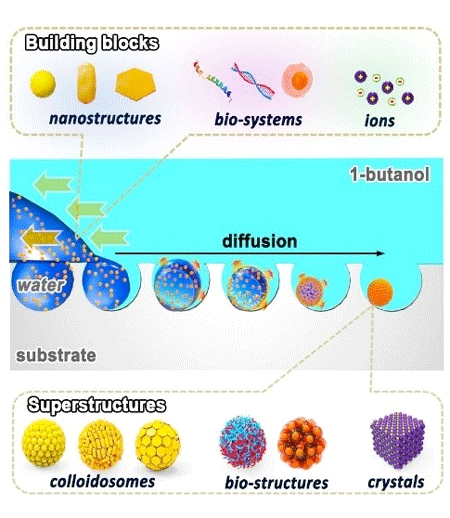| Apr 13, 2021 |
Scientists achieve self-assembly of superstructures at all scales
(Nanowerk News) The assembly of primary particles into uniform superstructures represent a compelling strategy to create new functions by utilizing interparticle electromagnetic coupling or other synergistic effects. Emulsion-based self-assembly strategies are ideal for superstructuring because of their simplicity and unnecessity of chemical modifications.
|
|
However, their long-standing downsides comprise of the polydisperse size distribution of emulsion droplets, the nuisance caused by employing emulsifiers (e.g., surfactants), and the difficulty in accurate positioning because of their unfixed fluid properties, which overall hinder governing the size, uniformity, and applications of the self-assembled superstructures.
|
|
Recently, researchers led by Prof. LI Yue from the Institute of Solid State Physics, Hefei Institutes of Physical Science and Prof. YIN Yadong from the University of California Riverside reported a robust and straightforward assembly strategy to create uniform superstructures at defined positions by introducing primary particles into templating holes via a transient emulsion (Matter, "Self-assembly of superstructures at all scales").
|
 |
| Schematic illustration of the self-assembly of the superstructures based on the template-assisted emulsion strategy. (Image: CAS)
|
|
This new approach is designed by taking advantage of the partial miscibility of water and 1-butanol, which makes it possible to generate transient emulsion droplets containing the target building blocks and carry them into templating holes patterned on a substrate. Further diffusion of water into 1-butanol depletes the emulsion droplets and drives the self-assembly of the building blocks within the templates, producing well-defined superstructures with the positional order defined by the template.
|
|
"This is a simple, low-cost, high-throughput and scalable way," said LI Yue, "it demonstrates high controllability and general applicability in producing superstructures."
|
|
They also found that the strategy can be employed to produce superstructures of various types and shapes of nanoscale materials, biological molecules, living cells, and inorganic compounds without the need for chemical modifications and surfactants, and guarantees their accurate positioning into desired spaces.
|
|
With the high controllability of the superstructure size, the applicability to building blocks of a wide range of dimensions, compositions and morphologies, and the ability of superstructuring at all scales, scientists believe this superstructuring strategy will have significant impacts not only on materials science but also on many other fields such as data storage, bio- and chemical sensing, and biomedicine.
|

